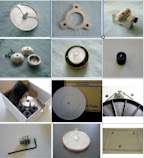Sharing with you here a very "COOL" Mid-Winter RP1 upgrade project by Joe Borzetta of Chicago, USA :
Thanks Joe!
 |
| Aluminium sub-platter, dual pulley and silicone belts upgrades |
Included a picture of my upgraded NAD C552. The upgrades went fine: the pulley installed without a problem, the sub-platter was indeed very tight to get in as the air under the shaft could not get out easily, it took a few minutes before the platter was in place (I turned it around and gently pushed on the top spindle). The 2 silicone belts were also quite easy to put in place thanks to your instructions. I now had a good week of listening and I do hear an improvement. The music sounds better, more steady, the details present on the record are easier to hear (almost in all records that I put on). I am all in all quite pleased with these improvements. As you can see on the picture I recently installed a new element (Ortofon 2M Blue) and that gave a boost to the turntable. Your pulley, aluminum sub platter and dual belts further improved the turntable and I conclude that the investment in the 2M Blue element is supported by your material. Regards, Jos Cenens Linden Belgium |
Thanks Jos Cenens!
Endrik of Philippines had earlier added my aluminium sub-platter to his P3-24 TT. Before I introduced the pulley puller, he was unsure of doing the dual pulley upgrade for fear that the motor might be damaged using the "hack method". Now with the help of the new pulley puller, he successfully upgraded his P3-24 TT with dual pulley and silicone belts.
Take a look at some of his additional tweaking ideas using bitumen and Kamagong pucks. Do you notice he has added a top bracing too?
Here's his comment and pictures with the upgrades:
Thanks Endrik.
Read more on Endrik's further upgrades on top and bottom bracings ..... >>>>
Antonio Amaral of Toronto, Canada is another RP6 owner who went for dual pulley with silicone belts upgrade. I believe many of us are curious to know if the dual pulley combo makes any difference to the performance of this well-esteemed RP6...

Here's the feedback and pictures from Antonio Amaral.

Here's the feedback and pictures from Antonio Amaral.
I have attached some pictures. Your double pulley gear is a definite upgrade for my Rega RP6. With the double pulley, I find that the music is more focused. Sound stage has widened slightly. Bass has slightly more impact and punch. I highly recommend the double pulley. Rega uses them on their higher end tables and now I can hear why. Many thanks. Antonio Amaral Toronto Canada |
 |
| Removing pulley with Pulley Puller |
Dual pulley installed
Silicone belts in place
Thanks Antonio!
You definitely must take a look at this project of Tommy Andersen from Denmark; you would be impressed by his ingenious way to conceal his wall-mounted slab. Even my wife who'd said before, " Nothing to be mounted on the wall, please!" now gladly return to me my Rega wall-mounting brackets ("confiscated" by her earlier).
I am exciting about trying out on my wall-mounting brackets! (Thanks to Tommy).
Here's Tommy Anderson's project in detail. Enjoy!
Thank you, Tommy for sharing your ideas with us!
I am exciting about trying out on my wall-mounting brackets! (Thanks to Tommy).
Here's Tommy Anderson's project in detail. Enjoy!
Many TT owners are sceptical about tweaking turntables. Other than to hear it for yourself, sometimes it's hard to be convinced just by the theory behind. But sure you can imagine the difference between a plain cake and another one with cherry on top!
Here's the feedback and pictures from F- H of Paris:
Hello Michael, I have received and installed the double pulley on my Rega P3. I had a short listening cession last night with two LPs : Miles Davis Kind of Blue and Archie Shepp Africa Blues. I confirm the double pulley is a great upgrade, the cherry on top of the cake ! Music is more “fluid” with a better timing, probably because of an improved speed accuracy and better belt-sub platter grip. As requested some pictures for your blog. Thank you so much. Best regards F- H from Paris |
Thanks, F- H !
Thomas from California, USA was the first Rega RP6 TT owner from North America to enquire on a dual pulley. Making the wrong assumption that his RP6 came with a 60Hz pulley like P5 (aren't RP6 a replacement for P5??), a 60Hz dual pulley was sent to him...
I was terribly wrong! And because of this, I had made Thomas and a few other RP6 owners waited longer than necessary for their dual pulleys. My sincere apologies here to them all.
So actually there is only one version of RP6 ; both North America and Europe are using the same 50Hz pulley and TTPSU like P7.
I was terribly wrong! And because of this, I had made Thomas and a few other RP6 owners waited longer than necessary for their dual pulleys. My sincere apologies here to them all.
So actually there is only one version of RP6 ; both North America and Europe are using the same 50Hz pulley and TTPSU like P7.
Thomas had finally settled his problem and here's his comments in vinylengine :
" I've had my RP6 for a little while now and I really love it, one thing that I had noticed over time was a little wow, most noticeable in long sustained notes. Not experience-ruining by any means, but I had read about the dual pulley upgrade and thought that might be a good way to shape it up. Contacted Michael, who said he had not seen this done on an RP6 yet. He said that the 60hz (N. American version) shorter pulley should work, so I ordered that + 2 of his silicon belts, and an acrylic mat just for fun, and off I went.
Received the parts from Michael about 1.5 wks after ordering (I'm in California). Michael provided good instructions for performing the surgery, which I more or less followed. I ordered a pulley puller from him, which worked well - just put down some strips of tissue to protect the plinth, twist away on the pulley puller, and hope that cracking sound you hear is the pulley glue and not the plinth.
Once the stock pulley is off, putting the dual on is a breeze - slide onto the spindle, find a good height, and tighten up the set screw. This is where I hit a minor snag in that the 60hz pulley was unfortunately not the right size. I had a moment of concern when I quickly compared the stock and 60hz, but chalked it up to difference in styling and pressed on. Upon trying to play a record and hearing it in slow motion... nope. The 60hz pulley is too small for my RP6.
Michael was very responsive and helpful, asking me to confirm the diameter of the stock pulley (3/4") and then sending a replacement 50hz pulley right away. Received it this morning (took about twice as long to get here due to the holidays) and the first glance tells me everything is going to be alright.
Set screw vs glue makes adjusting the pulley, or in this case replacing it, a breeze. Popped on the larger pulley - looking good (this shot may actually be the 50hz pulley, I took lots of pictures and now they're all mixed up - but you get the idea).
When I received the first shipment from Michael, I put one of his silicon belts onto the stock pulley to see how it sounded over the stock Rega belt. Immediately noticed an improvement, I would assume similar to what people have experienced with the white belts - everything focused up a bit, tighter bass.
I also tried replacing the stock felt mat with the acrylic one before fiddling with the pulley - dramatic change, bass much tighter and everything more airy. It kind of shifted the mix, if that makes sense - a more balanced presentation with more low and mid than the felt mat was putting forth.
Now that I've got the dual pulley added as well, I am overall very happy with everything I ordered from Michael. Starting and stopping is now faster (duh). Noise floor seems to be lower than it was in the previous configuration, not sure how much the pulley + belts can really impact this but I am hearing it - maybe I am just subconsciously choosing my most noise-free records (or they're the ones I like best because they sound good
A+ would buy again. "
Thanks Thomas!
Subscribe to:
Posts (Atom)














































